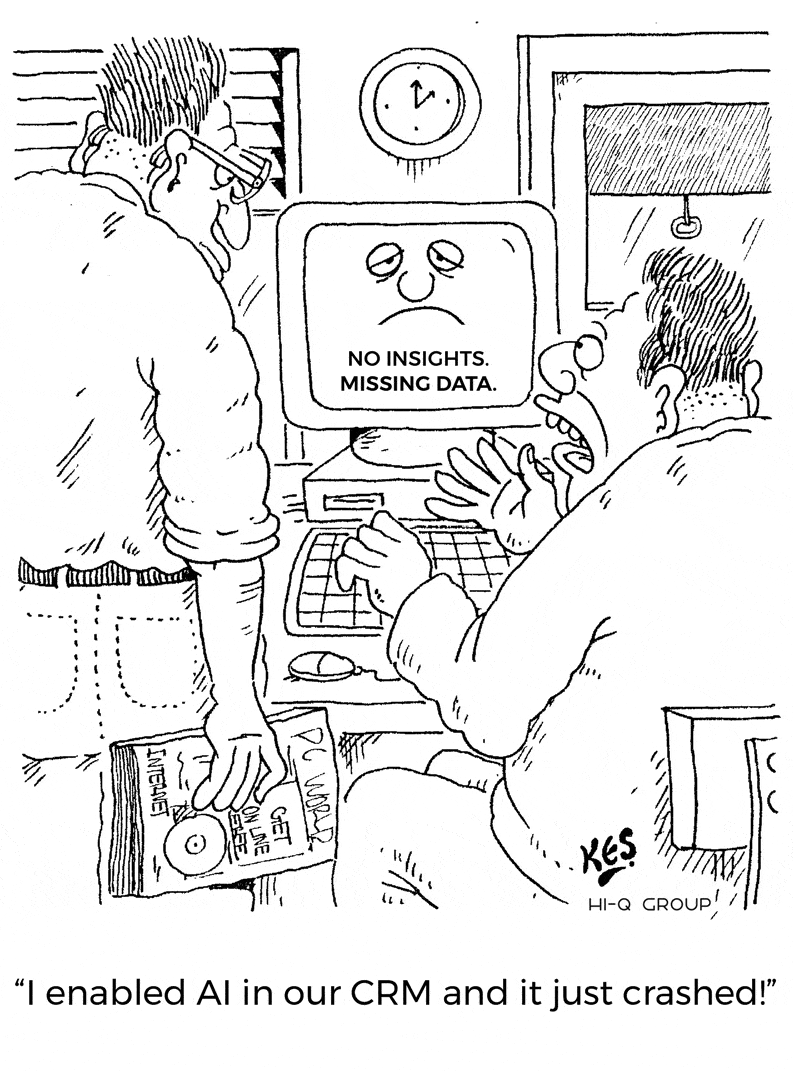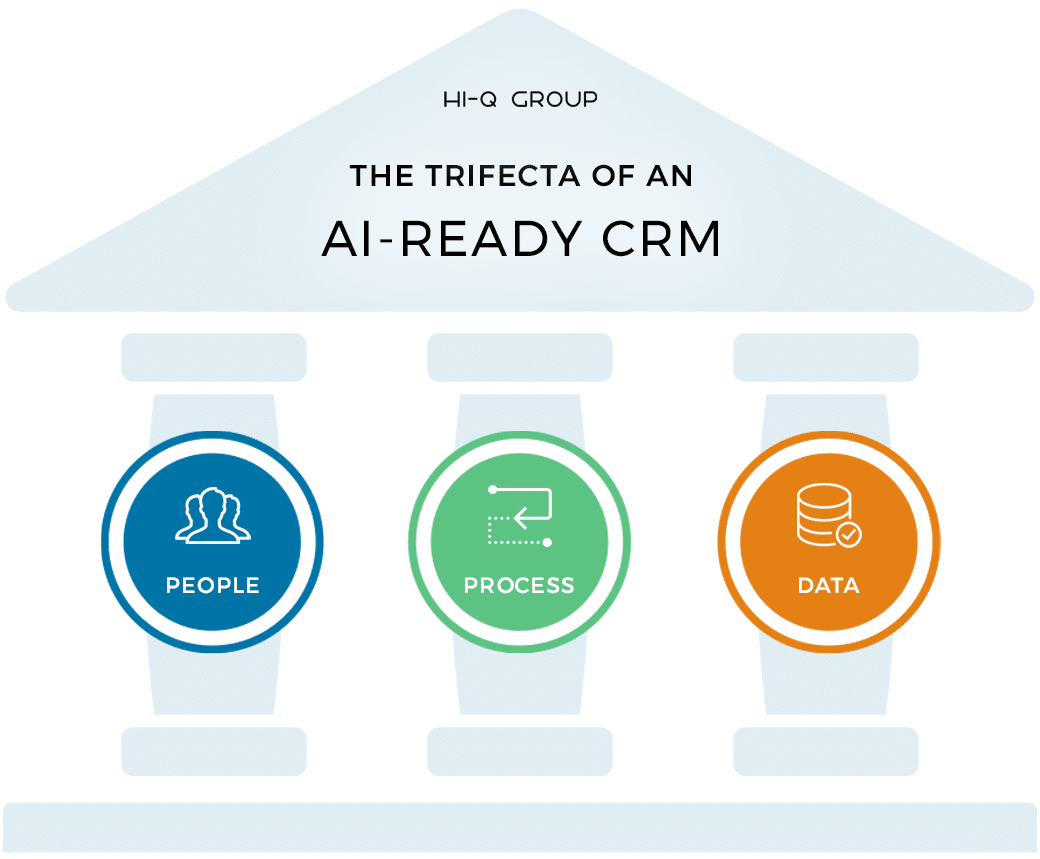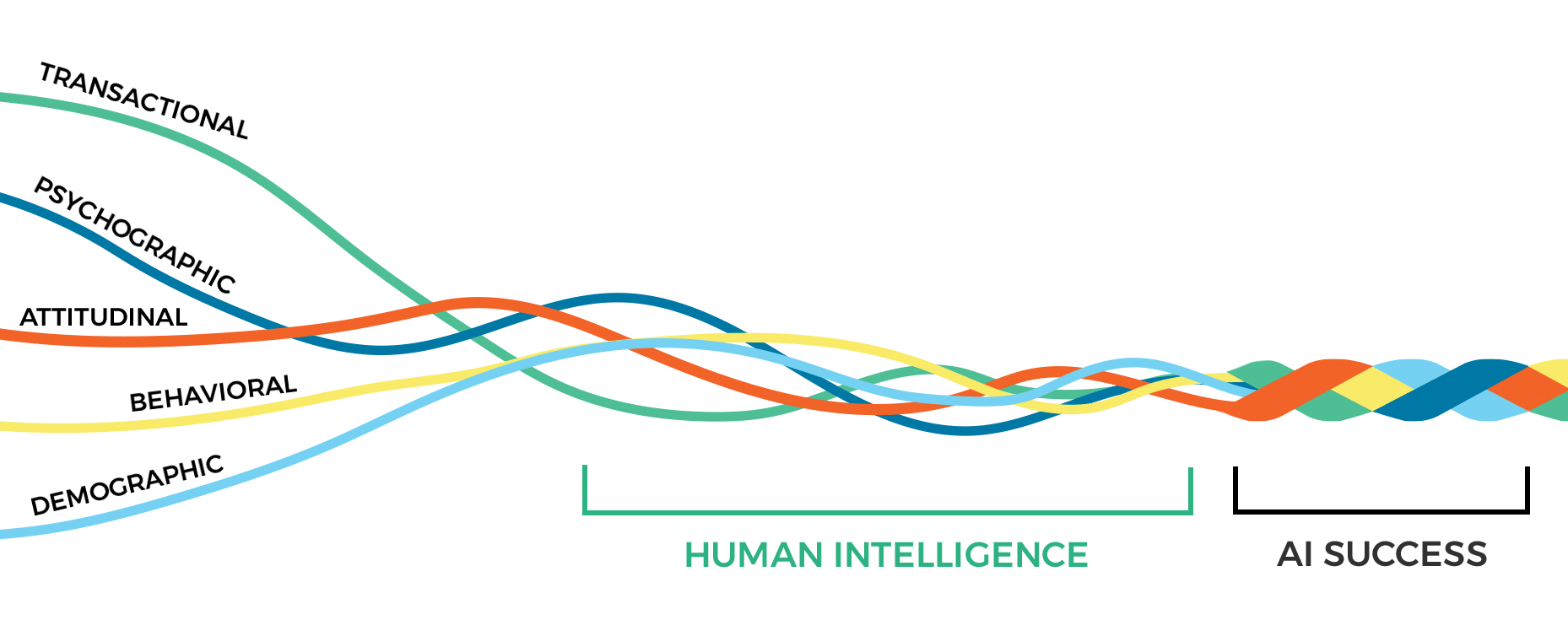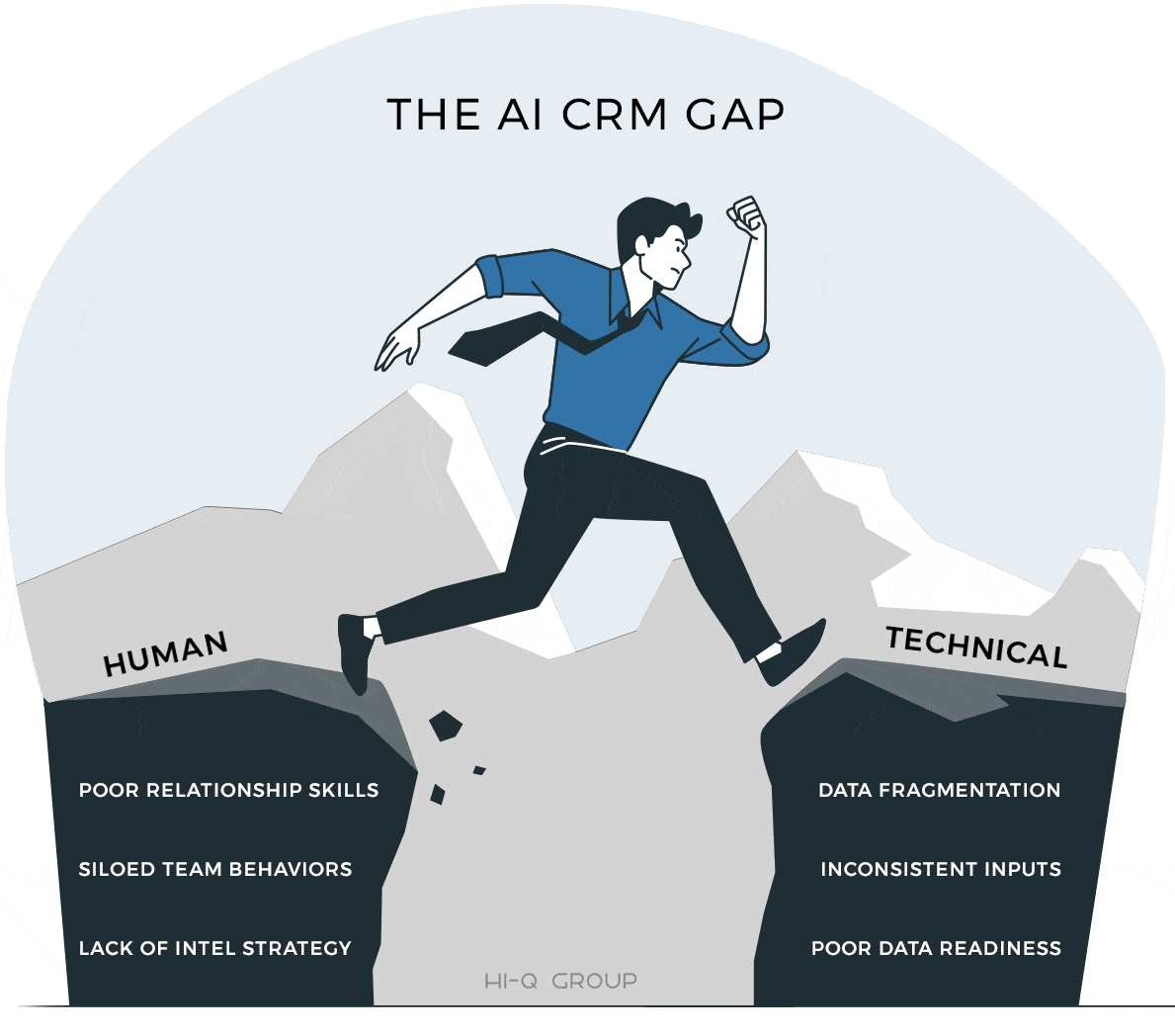executive snapshot
AI was intended to improve CRM productivity by enhancing customer understanding, but for most organizations it’s only made the noise louder. This guide explores why AI-CRM deployments so often fall short, what AI can and can’t solve, and how leaders can fix foundational gaps before scaling intelligence initiatives.
The pressure to implement AI quickly is an unescapable reality for many leaders. You can’t turn on the news today without hearing the latest “breakthrough” press release from companies eager to maintain investor faith in mounting competitive challenges.
76% of business leaders say they’re under growing pressure to drive business value with data, and 67% of data leaders feel pressure to implement AI quickly to demonstrate this value. Yet their biggest hurdle is still poor quality data. This gap between the demands of business value and the quality of their data is more problematic with AI.

“Don’t you call me a mindless philosopher,
you overweight glob of grease!”
C-3PO, Star Wars
“Don’t you call me a mindless philosopher, you overweight glob of grease!” C-3PO
AI-powered CRM promises sharper insights, predictive forecasting, and smarter revenue operations but as failed deployments show, most organizations fall short of the ROI they expect.
The reason is simple: AI can’t generate insights from systems that lack customer intelligence. Without fixing foundational CRM issues, especially the missing insights from frontline conversations, even the most advanced models underdeliver.
This guide shares lessons from failed AI+CRM initiatives, where AI excels (and where it doesn’t), the hidden costs of poor data readiness, and a blueprint to help leaders build CRM systems where AI can deliver true value.. Because while AI learns from patterns, it doesn’t understand emotion and human decisions are inseparable from it.
Without that context, even the smartest algorithms only see part of the picture.
The AI-Powered CRM Boom (and Gap)
Investment in AI + CRM has surged. In fact, the Generative AI in CRM market is projected to reach $144.9 million by 2033, growing at a compound annual rate of 20.8%.
The appeal is obvious:
- Predictive forecasting that flags which deals will close.
- Automated recommendations for next-best actions.
- Smarter segmentation for marketing and product alignment.
- Efficiency gains that reduce headcount needs.
Yet implementation outcomes tell a more cautious story.
Gartner’s latest data shows that 85% of AI projects fail to meet expectations, with poor data quality emerging as the most commonly identified cause.
The issue is that these systems are trained on incomplete, inconsistent, or irrelevant data. So they often miss critical intent data that captures human emotions, customer motivations, and the subtle cues behind buying behavior and predictable actions. Without that layer of human intelligence, even the most advanced AI produces unreliable recommendations (known as AI hallucinations) which quickly erodes user confidence.
In CRM specifically, readiness gaps are widespread. Nearly two-thirds of sales professionals say their company’s data isn’t ready for generative AI, and 41% of organizations have delayed or canceled AI initiatives altogether because of foundational data issues. For those trailblazers who pushed forward, 42% lack confidence in the accuracy and relevance of their AI outputs. We believe this figure will continue to grow over time.
Together, these figures reveal a disconnect between aspiration and infrastructure. While AI is rapidly reshaping the CRM market, most companies remain early in the maturity curve and often lack a clear view of where they truly stand.
The real gap is between technical and human skills. Leaders overestimate data quality while teams struggle with missing intel and fragmented systems.
This limited visibility causes many to overestimate their readiness and underestimate the effort required to turn AI into a dependable growth engine.
Although many have started to discuss this data readiness gap from a technical perspective, the gap is also human. AI can aggregate and analyze rational opportunity data, yet it cannot help teams create emotional connections with customers. And it can’t help them understand how to discover motivations and drivers across stakeholders involved in complex B2B sales cycles.
insight:
AI models with reasoning capabilities exhibit higher hallucination rates compared to simpler models, leading to poor decision-making and a system no one trusts. Without a layer of human intelligence, AI simply struggles to create significant value in real-world situations to execute, adapt, and create tailored customer experiences that drive growth.
Lessons from failed deployments
Across industries, leaders are discovering that AI performance issues rarely come down to technology fixes. They stem from the way organizations capture, manage, and communicate customer intelligence.
Through conversations with executives and their teams, and through our observations, we’ve found the problems AI exposes are often the same issues CRM has masked for years… and what leadership believes is happening inside their systems is often far from reality.
The frontline intel gap
The most advanced AI models can’t compensate for missing or poor-quality input. Research shows only 42% of sales professionals say they are confident in their data accuracy. This gap shows up clearly in our client discussions. Sales teams often manage deals through personal notes, spreadsheets, or Slack messages rather than their CRM.
REDDIT QUOTES HERE
For other customer-facing teams, the issue runs even deeper. Insights from service, support, and success conversations rarely make it into the system at all. There are usually no defined processes, incentives, or shared responsibilities for contributing this intelligence, so frontline employees don’t see the value in taking time away from their own priorities to enter data that primarily benefits another department. 46% of leaders state cultural resistance to sharing information contributes to their data silos, but rarely do they connect these dots for meaningful change.
In fact, most frontline teams are never trained to recognize or report on information critical for growth. Capturing those insights requires soft skills: the ability to read between the lines, uncover intent, and get the inside scoop from customers.
The result is a widening disconnect between what the organization knows and what the CRM shows.
Executive blind spots
When we speak to leadership, we hear a consistent theme: “Our CRM data isn’t perfect, but it’s fine.” Yet when we talk to their teams, we hear a different story—fragmented systems, missing context, and entire departments working in silos.
Executives are nearly twice as likely as their team to believe their CRM data is reliable, and that confidence gap remains one of the biggest barriers to progress. Many leaders assume CRM underperformance is a people problem—an issue of adoption or effort—when the real challenge runs deeper. It’s not simply that teams don’t have the incentive to use the system; it’s that they often lack the skills needed to recognize and report the kinds of insights that fuel growth.
The data discipline deficit
Even in larger organizations with designated data owners, data quality is rarely anyone’s full-time focus. We frequently hear from teams the person responsible for CRM data also manages multiple other priorities and rarely gets the investment or executive support required to maintain quality.

41% of companies have delayed or canceled initiatives due to poor CRM data, but many still hesitate to fund cleanup or governance efforts.
Leaders tend to underestimate the scale of the problem, believing that with more user compliance or a better tool, things will improve.
In reality, without disciplined data capture and cross-team accountability, AI doesn’t just mirror the existing chaos but turbocharges it.
Misaligned incentives and filtered truths
Another pattern we hear frequently is even when frontline teams do take the time to surface valuable insights, middle management often ignores or filters them before they reach senior leadership. In some cases, feedback is softened, reframed, or buried entirely to avoid friction or reputational risk.
This observation is backed by research. In a recent Validity study, at companies where decision-makers rely on data, 54% reported staff manipulates data to tell a story leadership wants to hear, and 45% went a step further, stating staff fabricates data.
Overcoming this requires a holistic culture and ecosystem where every level of the organization shares a growth mindset focused on the customer by developing the skills to recognize, elevate, and act on intelligence that drives improvement without judgment.
Lack of human intelligence strategy
This final lesson is at the root behind nearly every failed AI+CRM deployment.
Most companies have never defined a clear human intelligence strategy: a deliberate plan for how customer insight (not just data) is captured, shared, and acted on across the business.
Without that foundation, AI initiatives launch on unstable ground. Teams rush to activate integrations before establishing what intelligence matters most, how it will be maintained, or who is accountable for it. The result is a patchwork of tools, processes, and reports that generate activity but not alignment.
AI is only as good as the truth it’s given, and in most organizations that “truth” often consists of assumptions masquerading as facts.
Because customer conversations rarely reach the root cause, teams collect surface-level signals instead of meaningful insights. Frontline employees haven’t been trained to stay fully present or uncover what truly drives customer decisions, so valuable context never enters the system.
is your intel ai-ready?
Before adding new AI features, make sure
the foundation can support them effectively.
Our CRM Intel Assessment helps leadership teams pinpoint where valuable
customer insights break down, and which fixes will deliver the fastest impact.
Before adding new AI features, make sure the foundation can support them effectively.
Our CRM Intel Assessment helps leadership teams pinpoint where valuable customer insights break down, and which fixes will deliver the fastest impact.
Where AI does well vs. where it fails
Once organizations understand where intelligence breaks down, they can more clearly see what AI can — and can’t — realistically solve.
| What AI strengthens | Where AI struggles | Hidden costs if unaddressed |
|---|---|---|
| Automation: Lead routing, follow-ups, pipeline scoring | Missing context: Insights never logged (e.g., competitor mentions) | False opportunities waste valuable sales cycles |
| Pattern detection: Funnel leakage, churn risk, upsell signals | Emotional drivers: Cannot capture urgency, frustration, or sentiment | Erosion of trust as teams stop relying on AI due to limited or no value in outputs (hallucinations) |
| Summarization: Call transcripts, emails, and meetings condensed | Surface-level conversations: Can’t extract deep intel like drivers if teams don’t probe effectively | Limited ROI on AI implementations and missed competitive insights lead to stagnant growth |
| Normalization: Standardizing data across platforms | Organic intel gaps: AI fills missing context with confident but false insights | Revenue leakage from missed opportunities |
| Real-time alerts: Triggers on anomalies or opportunities | Bias amplification: Reinforces existing skew in CRM data | Strategic missteps when flawed intel drives decision-making |
| Personalization: Tailored recommendations based on patterns | Nuanced intent: Lacks human insight into emotional or shifting drivers | Generic strategies erode trust, increasing churn |
| Predictive analytics: Forecasting trends from historical data | Incomplete signals: Misses post-sale intel like renewal risks from delivery interactions | Inaccurate forecasts lead to revenue shortfalls and surprises |
Preparing your CRM for AI success
Recognizing these gaps is important but not enough. You need a foundational shift across three dimensions: people, process, and data.

PEOPLE
Equip teams to capture meaning, not just activity. Real intelligence starts with how customer-facing roles listen, probe and record customer context.
process
Create structured, repeatable flows for sharing and using intel, turning CRM into an active network of insight.
data
Prioritize completeness over volume. Reliable AI depends on disciplined entry, governance, and continuous feedback loops.
AI readiness starts here: when people, process, and data work in sync, insight becomes scalable.
People
AI can’t invent customer intelligence, it learns from it. Frontline teams need the skills and mindset to capture what truly matters: motivations, objections, urgency, and shifts in stakeholder alignment. Those insights become the context AI depends on.
Yet most people have never been trained to gather this kind of intelligence through meaningful conversations with customers or to open doors to new stakeholders. Empathy and self-control are the superpowers that make those conversations productive, and they remain skills that no algorithm can replicate.
Process
Sustainable insight requires consistent rhythms of capture, collaboration, and sharing across sales, delivery, and product. Automated processes help, but true intelligence depends on collaboration that turns data into informed decisions.
When intel moves fluidly through the organization, CRM stops being a static database and becomes an adaptive system—one that gives AI the connected signals it needs to be accurate. That’s why at Hi-Q Group, we focus on helping teams build the habits and alignment needed for consistent execution of complex strategies.
Data
Clean data is fundamental. But what separates successful AI deployments is data that’s both complete and enriched with human context. When your CRM reflects not only what customers do but also how they feel about your team and your solutions, AI can begin to produce insights that matter. Most organizations still miss this emotional dimension, as their systems are filled with activity logs, shallow meeting summaries, analytics, and usage statistics that say little about how customers are thinking or what they’re experiencing.
insight:
In short, technology should amplify human understanding—not replace it. Otherwise, more CRM or AI investments lead to less clarity and more wasted dollars.

Data is essential, but it’s not sufficient. Human judgment, conversation, and coaching are what transform information into outcomes. Technology can accelerate analysis, but it can’t replicate the trust, empathy, or chemistry that cause customers to buy.
Organizations that master these three dimensions build a CRM that’s truly AI-ready. One where technology amplifies real intelligence rather than erasing it.
when the foundation is fixed, ai works
Industry: SaaS (Cloud-Based Analytics Platform)
Size: 500M Annual Revenue | 2,500 employees | Global
Challenge: Usage Data ≠ Valuable Customer Intel
A global SaaS analytics firm analyzed its AI-powered CRM and discovered a critical flaw: usage data alone wasn’t producing valuable customer insight. The system surfaced generic recommendations that often missed client priorities. Across departments, teams kept their own notes and trackers, leaving the CRM full of activity but short on real intelligence.
Partnering with Hi-Q Group, the company standardized how customer priorities, urgency, and decision criteria were captured and shared. The new system was designed to promote reciprocity: when teams consistently collected and entered valuable customer intelligence, they received meaningful resources and recognition in return. This reinforced quality intel capture and built shared accountability. Shared dashboards and joint CS–Product reviews then bridged silos and aligned teams around consistent, trustworthy data.
The results were clear:
- Richer CRM datasets
- Sharper AI recommendations
- Stronger collaboration across sales, delivery, and customer success
- Forecast accuracy and deal velocity improved
- And most importantly, the CRM evolved from a reporting tool into a shared engine of intelligence and hitting growth targets
✦ CRM Intel Assessment: Pinpoint your intel gaps to improve actionable intelligence. ⇢
Once the intel foundation is fixed, AI begins to deliver measurable value. Which is increasingly evident in this analyses of why CRMs fail to translate customer data into meaningful insight and what leaders are doing differently.
The 8 principles for building an AI-ready CRM
By now, it shouldn’t come as a surprise that AI CRM readiness is built through consistent behaviors that align intelligence, process, and technology.
From our work with executive teams, Hi-Q Group has distilled a set of guiding principles that capture what separates organizations that make AI work in CRM from those that simply deploy it. These principles reflect the practices that consistently help teams turn intelligence into performance:

AI readiness starts here: when people, process, and data work in sync, insight becomes scalable.
1. Recognize AI as a multiplier, not a savior
AI amplifies what already exists (good or bad). Sustainable success starts with human-sourced intelligence that feeds reliable models.
2. Define clear uses cases and measurable goals
Align AI initiatives with business priorities such as forecasting accuracy, retention, and personalization.
3. Audit CRM intel gaps and data quality early and often
Identify bias, incompleteness, and silos before deployment to avoid scaling flawed assumptions.
4. Invest in frontline training and governance
Build the skills and accountability required to capture customer intent data and ensure consistent, high-quality inputs.
✦ CRM Intel Assessment: Pinpoint your intel gaps to improve actionable intelligence. ⇢
5. Establish repeatable processes for intel capture and sharing
Codify how insights move across sales, delivery, and product so data becomes dynamic, not static.
6. Harmonize and maintain data hygiene
Integrate and clean data sources in parallel with intelligence strategies to create a single, trusted view.
7. Phase AI adoption with high-trust use cases
Start small, measure results, and scale only after proving value and building team confidence.
8. Foster a culture of collaboration and accountability
Reinforce quality intel capture through feedback loops and tie outcomes directly to revenue and customer impact.
Winners are preparing for AI now
The lesson from failed deployments is clear: AI success depends on the strength of your data foundation.
Executives who prepare now by closing intel gaps, strengthening data discipline, and aligning people, process, and technology, will capture the true value of AI.
Those who don’t will repeat the costly failures of their peers.
is your intel ai-ready?
Most organizations discover their systems aren’t as “AI-ready” as they think.
Our CRM Intel Assessment helps leadership teams benchmark their
current state and pinpoint gaps in their customer intelligence.

WHAT’S UP NEXT:
Learn how to improve customer intelligence in B2B by combining AI and human intelligence by leveraging your frontline teams to find to actionable intel.
TOP LEADERSHIP QUESTIONS
how can ai in crm enhance sales for b2b businesses?
AI in CRM enhances sales for B2B businesses by automating lead scoring, personalizing outreach, and providing predictive analytics on customer behavior, shortening complex sales cycles and boosting win rates by up to 25%. Through ai-powered tools, CRM systems analyze customer data to optimize the sales process, forecasting deal outcomes and recommending next actions based on previous interactions.
In B2B, where customer relationships are key, AI enables conversational ai for dynamic customer interactions, improving engagement and revenue operations. Hi-Q Group’s Customer Relationship Score (CRS) integrates with AI-powered CRM to add relational depth, helping sales teams prioritize high-potential accounts and reduce churn through better customer relationship management. Overall, AI drives efficiency in sales pipelines by identifying patterns in customer data, allowing businesses to focus on strategic customer relationships.
which b2b businesses benefit most from using ai powered crm systems?
Enterprise businesses in B2B sectors like SaaS, manufacturing, and finance benefit most from ai powered CRM systems, where complex sales processes and large customer data volumes require automation for efficiency. These systems help manage customer relationships by analyzing previous interactions for personalized strategies, reducing churn in high-stakes environments. Startups and mid-sized firms also gain from ai-powered tools for scaling customer relationship management without large teams.
what are common applications of ai in customer relationship management?
Common applications of AI in customer relationship management include lead scoring, where AI analyzes customer behavior to prioritize prospects; chatbots for real-time customer interactions; and sales forecasting using predictive analytics on customer data. Other uses are sentiment analysis from previous interactions and automated personalization in sales pipelines.
what challenges do b2b companies face when implementing ai powered crm and how do they overcome them?
B2B companies face challenges like poor customer data quality, integration issues with legacy CRM systems, and resistance to AI integration due to complex sales processes. Hi-Q Group notes gaps in relational customer data hinder AI accuracy, and often cause hallucinations or repetition of corporate platitudes. To overcome, clean data, train teams, and use metrics like CRS for better customer relationship management.
what does ai powered crm do well?
AI powered CRM excels at automating lead scoring, providing predictive analytics for sales forecasting, and personalizing customer interactions based on customer data. It handles unstructured data for business intelligence and optimizes revenue operations in enterprise settings.
Examples where AI strengthens:
- Automation: Lead routing, follow-ups, pipeline scoring
- Pattern detection: Funnel leakage, churn risk, upsell signals
- Summarization: Call transcripts, emails, and meetings condensed
- Normalization: Standardizing data across platforms
- Real-time alerts: Triggers on anomalies or opportunities
- Personalization: Tailored recommendations based on patterns
- Predictive analytics: Forecasting trends from historical data
where does ai powered crm struggle?
AI powered CRM struggles with poor data quality, lacking emotional context in customer relationships, and handling unstructured data biases.
Examples of where it struggles include:
- Missing context: Insights never logged (e.g., competitor mentions)
- Emotional drivers: Cannot capture urgency, frustration, or sentiment
- Surface-level conversations: Can’t extract deep intel like drivers if teams don’t probe effectively
- Organic intel gaps: AI fills missing context with confident but false insights
- Bias amplification: Reinforces existing skew in CRM data
- Nuanced intent: Lacks human insight into emotional or shifting drivers
- Incomplete signals: Misses post-sale intel like renewal risks from delivery interactions
what are the hidden costs of poor implementation of ai powered crm?
Poor implementation of AI powered CRM leads to hidden costs like data cleanup, lost productivity from inaccurate actionable insights, eroded trust in crm systems, and ultimately, revenue loss.
Examples of hidden costs for B2B businesses if issues are unaddressed include:
- False opportunities waste valuable sales cycles
- Erosion of trust as teams stop relying on AI due to limited or no value in outputs (hallucinations)
- Limited ROI on AI implementations and missed competitive insights lead to stagnant growth
- Revenue leakage from missed opportunities
- Strategic missteps when flawed intel drives decision-making
- Generic strategies erode trust, increasing churn
- Inaccurate forecasts lead to revenue shortfalls and surprises
what are 3 areas that need addressed for an ai-ready crm?
Three areas that need addressed for an AI-ready CRM are people (training for intel capture), process (consistent workflows), and data (quality and enrichment).
what are the 8 principles of building an ai-ready crm?
The principles leaders should address include:
- Recognize AI as a multiplier, not a savior.
- Define clear use cases and measurable goals.
- Audit CRM intel gaps and data quality early and often.
- Invest in frontline training and governance.
- Establish repeatable rhythms for intel capture and sharing
- Harmonize and maintain data hygiene
- Phase AI adoption with high-trust use cases.
- Foster a culture of collaboration and accountability.
what’s the difference between traditional and ai powered crm?
Traditional CRM focuses on data storage and manual tracking of customer interactions, while AI powered CRM uses ai tools for predictive analytics and automation, transforming crm systems into proactive platforms. Traditional systems require human input for sales forecasting, but ai-powered crm analyzes customer data in real-time for intelligent insights. Hi-Q Group highlights that traditional CRM lacks relational depth, whereas ai-powered tools like those integrating a human intelligence layer will enhance customer relationship management investments.
why is ai important for modern crm solutions?
AI is important for modern CRM solutions because it transforms crm systems into intelligent platforms that provide actionable insights from customer data, enabling predictive analytics for better customer relationship management. In B2B, AI optimizes sales process and revenue operations by analyzing customer behavior for personalized customer interactions.
what is the future of crm in 2026?
The future of CRM in 2026 is marked by deeper ai integration and a shift toward adaptive ai systems that prioritize hyper-personalization, real-time actionable insights, and seamless automation across sales processes and revenue operations. CRM platforms will increasingly incorporate conversational AI and artificial intelligence for dynamic customer management, enabling businesses to predict customer behavior through advanced predictive analytics and data enrichment from unstructured data sources like emails and calls.
As AI powered CRM becomes more established, businesses will begin to also address their human intelligence layer, a critical component in their customer data strategy. Human intelligence has become a focus for leading-edge companies, as it is required for AI to produce meaningful customer insights and prevent AI hallucinations.
For B2B organizations with complex sales cycles, crm systems will evolve into AI-native tools that unify customer data across departments, enhancing customer relationship management by analyzing previous interactions to deliver tailored experiences and optimize sales pipelines.












